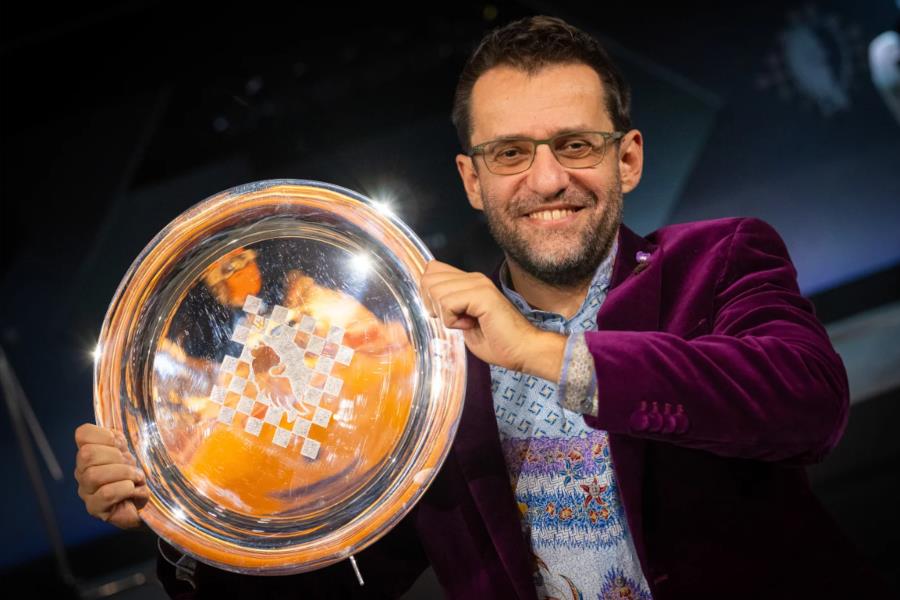One of the most creative players in the circuit triumphs in Las Vegas
The fifth and final day of the Freestyle Chess Grand Slam in Las Vegas concluded the tournament with four placement matches, including the Grand Final between Levon Aronian and Hans Niemann. Aronian won the final and secured his first Freestyle Chess title, while Magnus Carlsen won the match for third place against Hikaru Nakamura and kept his lead in the overall Grand Slam standings. The day also saw matches for fifth and seventh place.
In the Grand Final, Levon Aronian defeated Hans Niemann 1½–½. The first game ended in a draw. Niemann had some promising chances, especially in the middlegame, but Aronian held firm. In the second game, Aronian quickly gained a space advantage in the centre. Niemann made an inaccurate rook move during a tactical sequence, which allowed Aronian to win the exchange.
16…Re8 was Niemann’s mistake, as it allowed White to manoeuvre with his knight and infiltrate via b4-c6-e7 (the stronger alternative was 16…Rd7). There followed 17.Nb4 Rxe7 18.Nxc6 Rc7 19.d5
And now 19…Nf4 20.Ne7+ gains the exchange, as Black is forced to capture with the rook.
From there, Aronian took control and converted his advantage without any major difficulty. With this win, Aronian became the Las Vegas champion and earned the $200,000 first prize. He had reached the final after earlier wins over Magnus Carlsen, Hikaru Nakamura and Arjun Erigaisi, three formidable opponents.
Hans Niemann finished second in the tournament and took home $140,000. He had played well throughout the event, reaching the final with consistent results in both the group stage and knockout rounds. Although he fell short of the title, this marks one of the strongest performances of his career so far.

Levon Aronian with his daughter and wife, Anita Ayvazyan | Photo: Stev Bonhage

It was a great performance by Hans Niemann | Photo: Lennart Ootes
Grand Final games
Magnus Carlsen and Hikaru Nakamura met in the match for third place. It was a repeat of their final from the Paris Grand Slam earlier this year, although the stakes were lower this time. The first game ended in a quiet draw. In the second game, Carlsen quickly took the initiative and created problems for Nakamura early in the opening. Already in the early middlegame, Carlsen had a large advantage.
In this insightful video course, Grandmaster David Navara shares practical advice on when to calculate deeply in a position — and just as importantly, when not to.
Free sample video: Introduction
Free sample video: Invisible moves
First Carlsen gained a pawn advantage with 14…Bxa2, and then he saw Nakamura faltering with 15.Bxa4 bxa4, leaving the light squares around White’s king vulnerable. Carlsen soon castled kingside and began to create threats on the opposite flank with his active pieces.
The Norwegian maintained control and went on to win the game, securing third place with a final score of 1½–½. This result ensured that Carlsen kept his lead in the overall tour standings despite not reaching the final in Las Vegas.

Magnus Carlsen with main sponsor Jan Henric Buettner | Photo: Lennart Ootes

The much anticipated encounter between the two highest-rated players in the world | Photo: Stev Bonhage
Two more matches decided the remaining placements. Fabiano Caruana defeated Arjun Erigaisi 2–0 to claim fifth place. Caruana played solidly and won both games without needing tiebreaks. In the seventh-place match, Praggnanandhaa Rameshbabu defeated Wesley So with a score of 1½–½. Their first game was drawn, but Praggnanandhaa won the second to finish his tournament on a positive note.
Four players had already been eliminated earlier and did not play on the final day: Leinier Dominguez, Nodirbek Abdusattorov, Javokhir Sindarov and Vincent Keymer. These players all shared ninth to twelfth place in the final standings.
